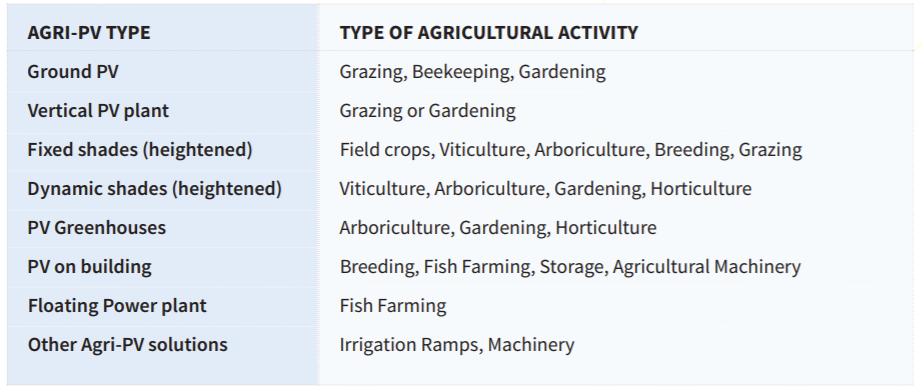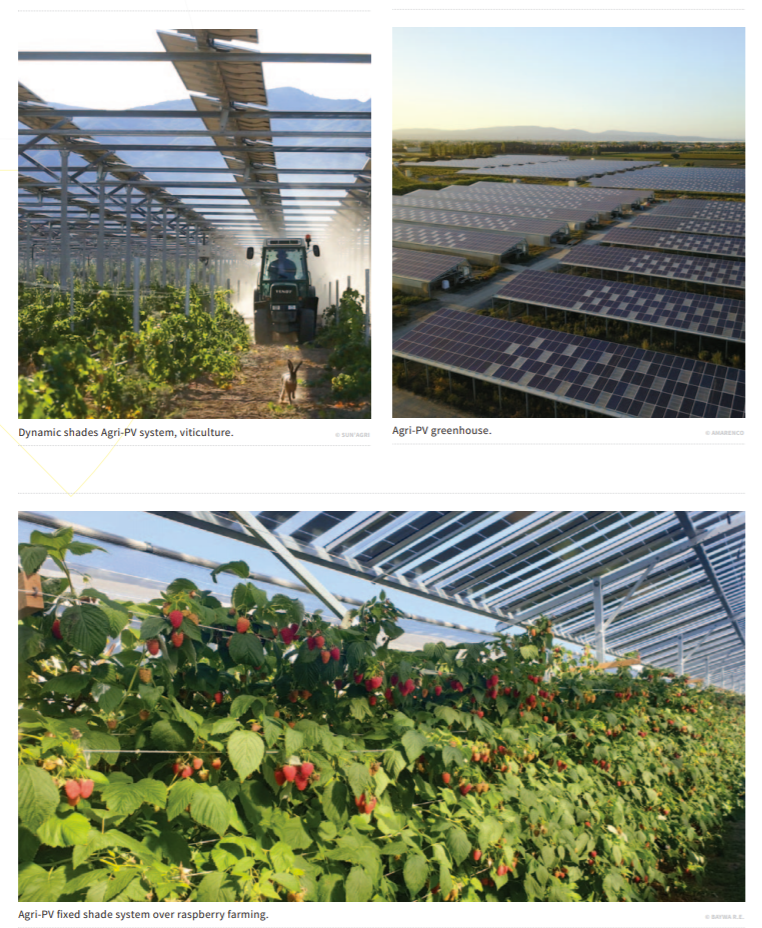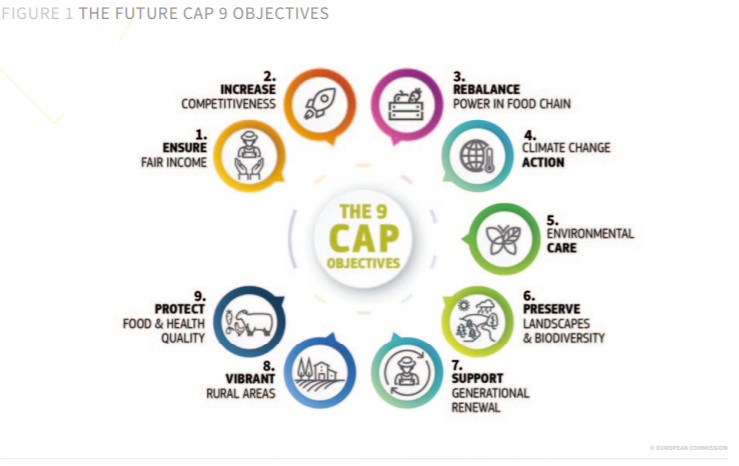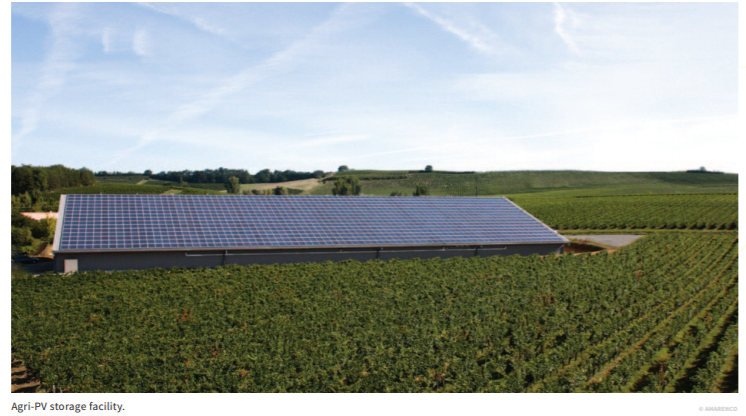Executive summary
Reaching the ambitious objectives of the European Green Deal will require a profound shift in the EU’s agricultural and energy sectors. Agricultural photovoltaics (“Agri-PV”) offers an innovative, efficient, and cost-effective solution to simultaneously promote sustainable agriculture and the clean energy transition. Agri-PV reduces land competition between solar and agriculture under conditions that guarantee the efficiency, sustainability, and viability of both activities. By combining agricultural infrastructure with solar, the EU can make rural communities more competitive and sustainable.
Solar, as the most scalable and cost-effective clean energy technology, empowers farmers to be at the heart of the European Green Deal and the post-COVID green recovery. Agri-PV supports the transition to a sustainable food supply and ecosystem, channeling new investments in solar capacities, and supporting the objectives of the Common Agricultural Policy and of the Farm to Fork Strategy. As a disruptive set of technologies, innovative AgriPV solutions can drive the modernisation of the EU’s food system and increase its resilience to climate change. Finally, thanks to its high land-use efficiency, Agri-PV is particularly suited to boost the clean energy transition in land-scarce regions, such as EU islands.
The potential for Agri-PV in the EU is immense: if Agri-PV were deployed on only 1% of Europe’s arable land, its technical capacity would be over 700 GW. Tapping into this potential would place the European solar industry at the forefront of global solar innovation. The sector is already emerging in Europe, with certain Member States actively supporting its development, and this has triggered strong interest from emerging countries faced with the
challenge of droughts and climate-related transformations. It is time for a coordinated effort to boost the development of Agri-PV across Europe.
Introducing Agri-PV
The European Green Deal sets out a vision to achieve climate neutrality by 2050. This will require a deep transformation of Europe’s society and economy; particularly of its energy and agri-food sectors. The Clean Energy Package (“CEP”), adopted by the European Union in 2019, set out a framework to reduce greenhouse gas emissions by 40% by 2030, partly by reaching at least 32% renewable energy in the final energy demand. In 2020, the European Commission proposed the European Climate Law, which would set a legallybinding target of net zero greenhouse gas emissions by 2050, in addition to more ambitious 2030 targets.The EU has a key role to promote the multiple synergies between agriculture and solar electricity generation
enabled by Agri-PV systems. Installed directly above crops, solar provides shade, protects crops against hail or frost, enables stable crop yields, and increases the electrical yield of PV panels.2 Solar can be installed on agricultural hangars or on greenhouses and can support
the development of modern infrastructure that improves the competitiveness of the agricultural sector. Utility-scale solar farms provide the perfect setting for sheep to graze.3
Overall, there have already been a vast number of methods of integrating solar onto agricultural infrastructure,* with innovations regularly appearing on the market. Public policies should boost the deployment of established Agri-PV systems, while simultaneously supporting innovative Agri-PV solutions.


It has been estimated that deploying Agri-PV on only 1% of global cropland could help meet total global energy demand.4 Since 2014, around 2,800 Agri-PV systems have been deployed worldwide, with a total capacity of about 2.9 GWp5 The sector has seen significant growth in Japan, South Korea, and China, where regulatory frameworks and support schemes have already been in place for a number of years.
Enabling sustainable development in rural areas
In addition to the full implementation of the CEP, and specifically the Renewable Energy Directive,8 the European Union and its Member States should encourage the development of Agri-PV in Europe through at least four policy initiatives:
- The revision of the CAP: Agri-PV can enable the achievement of the CAP’s objectives. The second pillar of the CAP should promote the deployment of Agri-PV and Member States should include Agri-PV development plans in their CAP Strategic Plans.
- The implementation of the Farm to Fork Strategy: Agri-PV can be at the core of a modern, sustainable, healthy, and equitable food system. The horizontal implementation of the Farm to Fork Strategy should integrate the various contributions of Agri-PV to increase sustainability, improve resilience, and boost innovation in the agri-food sector.
- The revision of the EU Climate Change Adaptation Strategy: Agri-PV solutions contribute to the climate resilience of agricultural practices. The revised EU Climate Change Adaptation Strategy should provide targeted support for Agri-PV solutions that improve the resilience of agriculture to climate change.
- The Clean Energy for EU Islands initiative: land-scarce regions are particularly suited for the deployment of Agri-PV. The EU islands should integrate plans to deploy Agri-PV to support food and energy security for their clean energy transition agendas.

The implementation of the Farm to Fork Strategy should place Agri-PV at the centre of the Energy System Integration strategy in rural areas. By enabling the development of Agri-PV projects through collective selfconsumption schemes and rural renewable energy communities, Europeans living in rural areas can be part of the transition towards a more circular and sustainable energy system. This would support a Just Transition, allowing rural communities to benefit from electrified transport, heating and cooling, and agricultural machinery. Furthermore, Agri-PV can drive innovation in the agricultural sector and enable the next generation of climate neutral farms. The upcoming Horizon Europe, through the Farm to Fork Green Deal call area,36 should include specific project calls to support Agri-PV research, with a focus on projects at TRL 5 to 9.

Six actions to boost rural development through Agri-PV
The EU and its Member States have a golden opportunity to boost rural development while
simultaneously deploying renewable energy. The deployment of Agri-PV solutions can enable the achievement of the 9 objectives of the CAP, power future climate-neutral farms, make the agricultural sector more resilient, and support the decarbonisation of EU islands. Supporting Agri-PV would further put the EU at the forefront of a key innovative solution to the challenges of the clean energy and sustainable agriculture transitions.
To unleash these benefits, the EU and its Member
States should implement 6 key actions:
- The European Council and the European Parliament should integrate a “European Agri-PV strategy” within the future CAP that aims to promote the development of the Agri-PV sector across Europe.
- Member States should, as part of CAP Strategic Plans, develop Agri-PV regulatory frameworks and prioritise investments into solar.
- The European Commission should mainstream AgriPV across initiatives part of the Farm to Fork Strategy.
- The European Commission and EU Member States should provide targeted support for Agri-PV research programmes.
- The European Commission should integrate Agri-PV within its upcoming Climate Change Adaptation Strategy.
- EU islands should deploy Agri-PV as part of their clean energy transition agendas.
Source: Solar Power Europe

You must be logged in to post a comment.